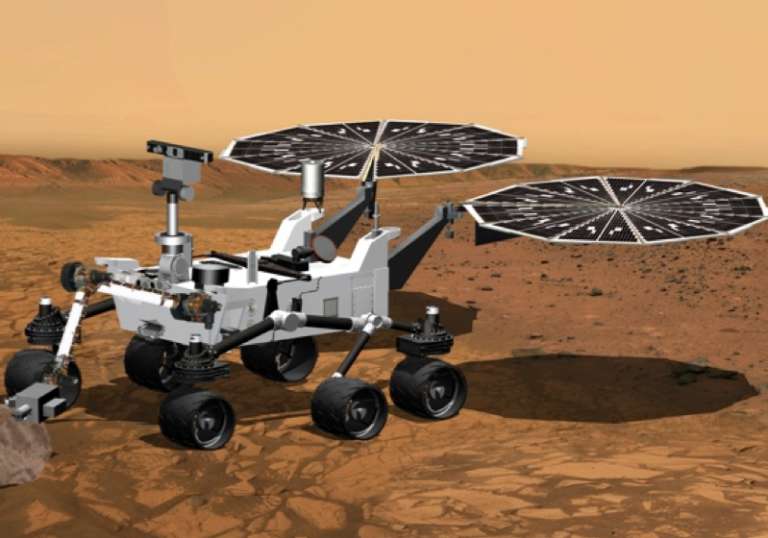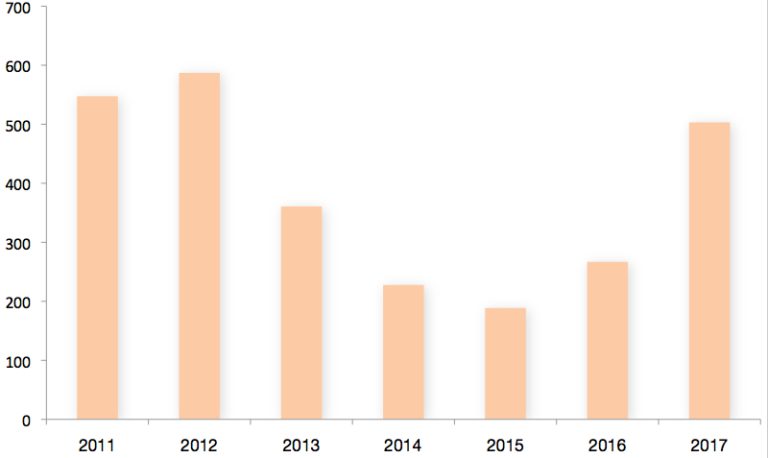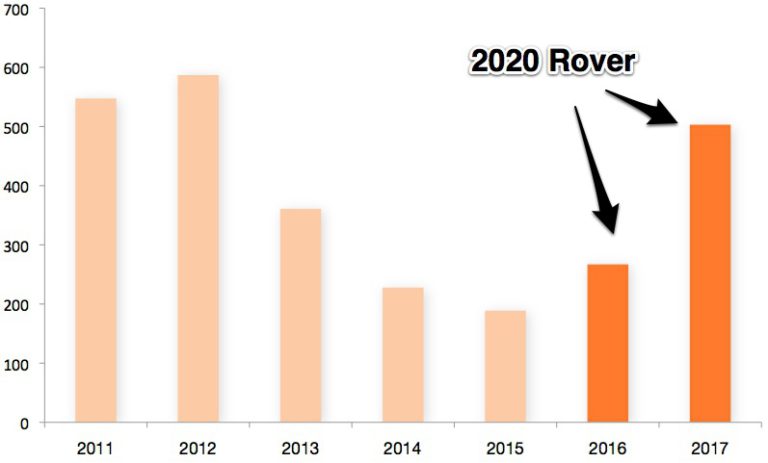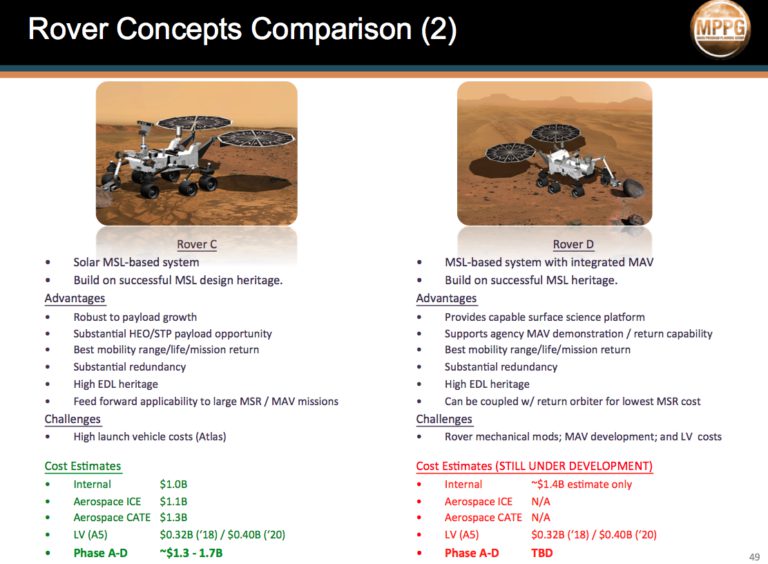Casey Dreier • Dec 05, 2012
The 2020 Rover in Context
Dr. John Grunsfeld, Associate Administrator for the Science Mission Directorate at NASA (which controls the entire science budget in the agency), upset my plans of attending a fun NASA Social event today by announcing a new MSL-like rover to land on Mars in 2020. This rover will save money by using the same general design as Curiosity, even going so far as to incorporate spare parts left behind by the current Mars rover. The science instruments have yet to be defined, and it may or may not acquire and store samples of the Martian soil to be retrieved by a future mission to return them to Earth. It was a major announcement, solidifying plans by NASA to continue the long-term study of Mars.

On first blush this sounds like win for the planetary science community and fans of space exploration - and in many ways, it is. A new mission to Mars is always something to celebrate. But a closer examination of the facts reveals that this announcement does not in any way alter the reduced funding levels for planetary science.
Today's announcement brought out a lot of frustration from parts of the scientific community that feel like NASA gives too much attention to Mars at the expense of other targets (like Venus, Uranus, Titan, Enceladus, or Europa). It also caused consternation among some Mars scientists because it was not labeled as a "caching mission," the first step in a multi-mission campaign to return samples from Mars to the Earth and the highest-priority mission in the Decadal survey. Many in the public saw it as merely "another MSL" that costs billions of dollars.
After spending a lot of time today questioning John Grunsfeld, Jim Green (Planetary Science Division Director at NASA), and many other planetary scientists, I've come to the following conclusion:
Many people have misunderstood today's announcement. On the surface, it sounded like NASA made a major policy decision on the future of solar system exploration. However, upon examination of the 2013 budget, it turns out that the 2020 rover mission is perfectly consistent with the reduced funding priorities from ten months ago.
Let me repeat that. NASA's budget for planetary science has not changed from its proposed 2013 levels. The priorities have not changed. The distribution of funds within the Planetary Sciences division has not changed. The Planetary Science division still stands to suffer a $309 million cut in 2013.
Ok, so what exactly is going on? How can NASA afford this new rover?
First, we need to understand a little bit about the budgeting process (yes, I know, but bear with me, it's worth it).
In February of 2012 the President released a proposed federal budget for the fiscal year 2013 (which runs from Oct 1st, 2012 to Sep 30th, 2013). It included a large cut to NASA's Division for Planetary Science - about 20% - much of which came out the Mars Exploration Program.
The Mars Exploration Program (MEP) is a line-item within the Planetary Science budget. This is a bucket of money that NASA devotes to the exploration of Mars, and it currently funds all active Mars missions and research programs. The MEP is a separate bucket of money from the Discovery program, which funds missions like InSight and Dawn, and the New Frontiers program, which funds missions like OSIRIS-REx and Juno.
Another key point is that the White House's budget contains projected spending allocations for the next five years. This helps agencies plan their long-term projects. The 2013 budget contained the five-year budget allocation for the Mars Exploration Program. Here's what it looked like yesterday, before the announcement:

Remember, these numbers are directly from the 2013 budget request which was released in February. Notice that in 2016 the program's budget starts to increase again. Looking more deeply into the budget request, one notices that the increase is due to a line-item named Mars Next Decade. This was a placeholder name for a yet-to-be-determined Mars mission that today became the 2020 rover.
So here's the Mars Exploration Program budget projection after today's announcement of the 2020 Rover mission:

The numbers are exactly the same. They have to be. The 2013 budget request from the President was officially released ten months ago and cannot be revised by individual agencies. Also, John Grunsfeld and Jim Green technically work for the President. They cannot publicly disagree with official policy, and they certainly cannot go around modifying their official budget to pay for new programs. As Jim Green put it to me (and I paraphrase here), if he or Grunsfeld changed their budgets without approval and told the public about it, they would not have jobs to go home to.
I'm going to say this again because I feel like I cannot emphasize this enough. Today's announcement essentially designates money already set aside for a Mars mission to a specific mission concept. That's it. It did not take money away from outer planets missions, because in the 2013 budget there is no funding for outer planets missions. It did not unfairly prioritize Mars over other planets because this money had already been prioritized to Mars back in February.
The mission that was defined today was essentially a variant of one of the mission proposals from the Mars Program Planning Group (MPPG), which was tasked to create missions that would fit within the 2013 budget constraints. In fact, it sounds a lot like a variant of Option C:

Under the limited funding available in the 2013 budget projections, 2020 was the earliest date at which a rover mission was possible.
There are very valid criticisms to the 2013 budget for Planetary Sciences. We here at the Society have been working hard to reverse the cuts back to the division so we can pursue missions to Europa and other targets via Discovery-class missions. But nothing that was said today changes any of that.
So if you were disappointed by today's announcement because you were hoping for something different than Curiosity, don't get upset at NASA, John Grunsfeld, Jim Green, or the Mars program.
Funnel your frustration (or excitement) into activism. If we restore funding for planetary science back to $1.5 billion/year, NASA could pursue a 2018 Mars caching rover, a Europa mission, and a new Discovery mission in 2015. It's a small, small amount of money by government standards.
Today solidified NASA's commitment to the continued exploration of Mars. That is a good thing. But it didn't alter the fundamental challenges facing NASA's Planetary Sciences program. We still need to Save Our Science and reverse the cuts. There are so many places to go, and it takes so little to get us there.
The Time is Now.
As a Planetary Defender, you’re part of our mission to decrease the risk of Earth being hit by an asteroid or comet.
Donate Today

 Explore Worlds
Explore Worlds Find Life
Find Life Defend Earth
Defend Earth

